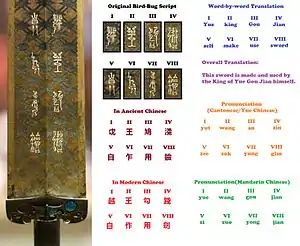| Bird-worm seal script Niao Chong script | |
|---|---|
| Script type | |
| Created | c. 771–476 BC |
Time period | Spring and Autumn period, Zhou dynasty, Warring States period |
| Languages | Old Chinese |
| Related scripts | |
Parent systems | Oracle bone script
|
Child systems | Bird seal script, Worm seal script |
Sister systems | Seal script |
| Bird-worm seal script | |||||||
|---|---|---|---|---|---|---|---|
| Traditional Chinese | 鳥蟲篆 | ||||||
| Simplified Chinese | 鸟蟲篆 | ||||||
| Literal meaning | bird worm seal | ||||||
| |||||||

The bird-worm seal script (Chinese: 鳥蟲篆) is a type of ancient seal script originating in China.
Names
The Chinese character 鳥 (niǎo) means "bird" and the character 蟲 (chóng) means "insect", but can also mean any creature that looks like a "worm", including invertebrate worms and reptiles such as snakes and lizards (and even the Chinese dragon). The character 篆 (zhuàn) means "seal (script)".
Other names for this kind of seal script:
- Niao-chong script (Chinese: 鳥蟲書; pinyin: niǎo chóng shū). The Chinese character 書 (shū) means "script" here.
- Niao-chong characters (Chinese: 鳥蟲文; pinyin: niǎo chóng wén). The Chinese character 文 (wén) here means "script".
There are two subcategories (sub-styles):
- Bird seal script (Chinese: 鳥篆; pinyin: niǎo zhuàn; Chinese: 鳥書; pinyin: niǎo shū[1]
- In this style, some parts of characters have a bird-like head and tail added. The bird style sign is a combination of two parts: a complete seal script character and one (sometimes two) bird shape(s).
- Worm seal script (Chinese: 蟲篆; pinyin: chóng zhuàn; Chinese: 蟲書; pinyin: chóng shū)
- In this style, some or all the strokes are winding, thus producing a worm-like character, but there is no additional bird shape.
Introduction and history
Seal script evolved from oracle bone script, and diverged into different forms in the Spring and Autumn period, after the power of the Zhou dynasty waned and China began to divide into different states.
This kind of seal script first appeared in the middle era of the Spring and Autumn period. It then became popular during the late Spring and Autumn period, and was most popular during the Warring States period. It was often seen in kingdoms such as the Wu (roughly today's Jiangsu Province), Yue (roughly today's Zhejiang Province), Chu (roughly today's Hunan and Hubei provinces), Cai, Xu, and the Song. Each state in China during the Warring States period had its own variety of script.
These kinds of seal script declined after the Qin dynasty, most likely due to the unification of writing scripts by Qin Shi Huang (unified into the small seal script), after his unification of China, although they were used during the Han dynasty.[2]
Usage
The bird seal script is often seen on bronze and iron antiques of the Yue Kingdom (roughly today's Zhejiang Province). The script was used on bronze and iron weapons, like swords, to indicate ownership or date of completion. The characters engraved on the famous Sword of Goujian provide a fine example. A few examples of the bird seal script can be seen in or on containers and jades of that period. The bird seal script was also used occasionally in the Han dynasty seals (mainly the jade seals), as well as a few eaves tiles and bricks.[3]
The worm seal script is more common in, and probably originated from the Wu Kingdom (now roughly Jiangsu Province) or Chu Kingdom (now roughly Hunan Province and Hubei Province). Examples can be seen on antique bronze weapons, containers, jades, and seals (mainly the bronze seals of Han dynasty),[4] and constructional or decorative parts like tiles, etc. The characters on the famous Spear of Fuchai are a good example of this category of seal script.
See also
References
- Shuowen Jiezi, by Xu Shen. (It mentioned the bird-worn seal script was one of the eight writing scripts in Qin dynasty ("秦书八体"), so it was still used in Qin dynasty.)
- Cao Jinyan (曹锦炎). 鸟虫书通考 [General Study of Bird-Worm Seal Script]. ISBN 978-7-80512-849-8.[5]
- Xu Gupu (徐谷甫). 鸟虫篆大鉴 [The Great Collection of Bird-Worm Seal Script]. Shanghai Bookstore Press. ISBN 7-80569-368-4.[6]
- ↑ Lin, Yutang (1967). Yutang Lin (ed.). The Chinese theory of art: translations from the masters of Chinese art. Putnam Sons. p. 44. ISBN 9789080030978. Retrieved 2011-10-11 – via the University of Michigan.()
- ↑ Huang, Qi (2004). Qi, Gong; Norman, Jerry; Huang, Qi; Wang, Helen (eds.). Chinese characters then and now. Ginkgo. Vol. 1 (illustrated ed.). Springer. p. 34. ISBN 3-211-22795-4. Retrieved 2011-10-11.
- ↑ Gu Songzhang (谷松章) (2006). 鸟虫篆印技法解析 [The Analyses on the Techniques of Bird-Worm Script Seals]. Chongqing Press. ISBN 7-5366-7659-X.
- ↑ "鸟虫篆印" [The seal of bird-worm script]. Hudong (in Chinese). Beijing.
- ↑ Book information: General Study of Bird-Worm Seal Script, by CAO Jinyan; Shanghai Painting and Calligraphy Press; June 1999 Archived March 8, 2010, at the Wayback Machine
- ↑ "The Great Collection of Bird-Worm Seal Script, by Xu Gupu; Shanghai Bookstore Press". Archived from the original on 2016-03-07. Retrieved 2009-09-23.